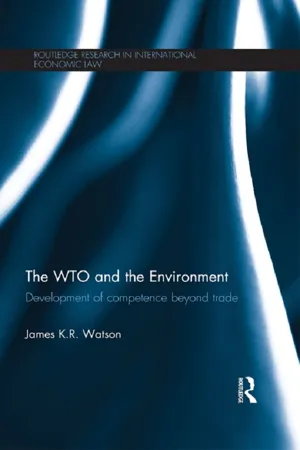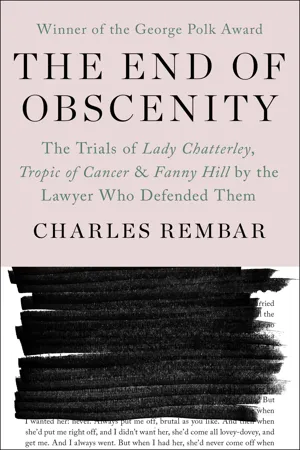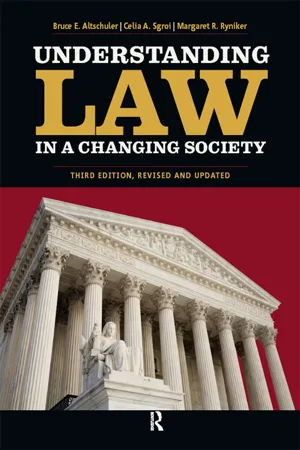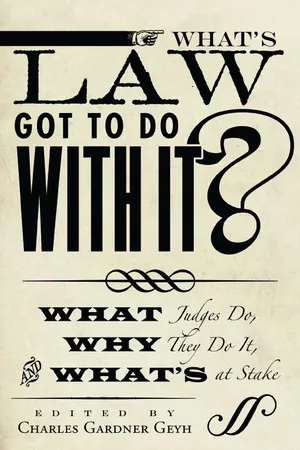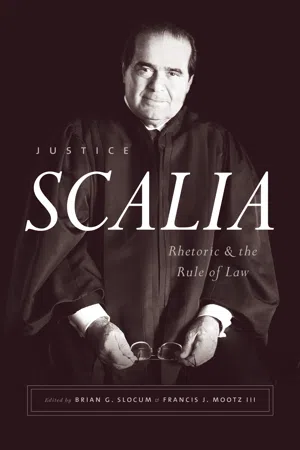Politics & International Relations
Stare Decisis
Stare decisis is a legal principle that means "to stand by things decided." It refers to the practice of courts following the precedents set by previous decisions. This principle provides consistency and predictability in the legal system, as it ensures that similar cases are treated similarly.
Written by Perlego with AI-assistance
Related key terms
6 Key excerpts on "Stare Decisis"
- eBook - ePub
The WTO and the Environment
Development of competence beyond trade
- James Watson(Author)
- 2013(Publication Date)
- Routledge(Publisher)
The quote from O’Connell is directly linked to the workings of international lawyers at the ICJ. Indeed, as a part of a settled and predictable legal system it is considered that consistency of decision is of paramount importance:It is a fundamental principle of the administration of justice that like cases should be decided alike. Inconsistency in judicial decisions affronts even the most elementary sense of justice. In this sense the principle of Stare Decisis , of abiding by previous decisions, figures prominently in most legal systems, including all of those of the Member States of the (European) Communities.10This suggests that reliance on legal decisions has a strong part to play in the international legal system, though the question of whether precedent is also in play is disputable:Precedents are not binding authorities in international law, but the English theory of their binding force merely elevates into a dogma a natural tendency of all judicial procedure. When any system of law has reached a stage at which it is thought worth while to report the decisions and the reasoning of judges, other judges inevitably give weight, though not necessarily decisive weight, to the work of their predecessors.11Therefore the consideration of precedent in the international arena may well be different from that of a precedent with a binding nature at a national level, such as that in the UK or USA. It is out of a concern for consistency to consider like cases alike, rather than a bound duty. The process of international tribunals looking to previous decisions does not need a specific treaty provision to endorse it; this is simply a normal practice of decision-making bodies.12It can also be stated that reliance on decisions in international law exists because the form of law often requires judges and advocates to determine whether or not they have dealt with a similar problem before.13 If they have it is often the case that they will return to the reasoning of that case to determine if it can be applied to the present dilemma. This can be seen clearly in the words of King James I: ‘Reason is too large. Find me a precedent and I will accept it.’14 - eBook - ePub
The End of Obscenity
The Trials of Lady Chatterley, Tropic of Cancer & Fanny Hill by the Lawyer Who Defended Them
- Charles Rembar(Author)
- 2015(Publication Date)
- Open Road Media(Publisher)
Rules of law are, in their essence, rules of degree. Cases of the same degree occur only rarely; Parmenides is present, but Heraclitus dominates. You cannot, because the water flows, enter the same stream twice. Even if all the testimony and all the documents in the matter at bar were precisely the same as those in the precedent cited, the two cases would not be the same. In the time between, the world would have changed. The world as it exists when the case is tried itself is a fact in the case.A rigid insistence on repeating earlier decisions is in reality a denial of the principle. A true devotion to precedent may require different results in situations superficially similar. Stare Decisis is hardly rule by rote; it is rather a gravitation toward the legal experience of the past. Allowance having been made for change in circumstance, it demands that courts should try to decide things now as they decided them before—subject always to the capacity for modification that is part of each living cell of the law. Courts are naturally influenced by what seems just in the specific human situations before them, but they have no authority to decide each case solely according to what seems just, and they rarely—very rarely—make a rule that is entirely new. Indeed in some fields of law, where it is especially important that there be freedom to act in reliance on a given legal fundament, courts will not wander from what is established; they wait for legislatures to make the move. And throughout the law, the courts are not likely to change their ways very much at a time.There are several reasons why they are not:(1) Stare Decisis is an anticorruption device. If courts are not bound by external rules, if they are not called upon to explain their decisions in terms of precedent, corruption is made easier. “What is right” in a particular case too readily becomes what is right for the particular judge or his friends. There should be a single set of laws for rich and poor alike; that much is easy. There should also be one set of laws for those who helped the judge get on the bench and those who opposed, for those who have good stock-market information to give the judge and those who don’t, for the political clubhouse and the rest of the neighborhood, for the organized group and the unattached private citizen. Stare Decisis - eBook - ePub
- Bruce E. Altschuler, Celia A. Sgroi, Margaret R. Ryniker(Authors)
- 2016(Publication Date)
- Routledge(Publisher)
Payne, it is useful to discuss the doctrine of Stare Decisis and the various criteria that are traditionally viewed as legitimate for overruling precedents.I. Overruling Precedent in the Supreme CourtThe doctrine of Stare Decisis is deeply rooted and prominent in American jurisprudence. In accordance with the doctrine, when a court determines that Stare Decisis does not apply in a particular context, it may legitimately, and should, overrule a precedent. The scholarly debate about Stare Decisis therefore centers on what requirements should be imposed as a precondition to finding that Stare Decisis should not apply. The controversy surrounding Payne specifically addresses when the Supreme Court must follow its own precedent. As a background to analyzing the Court’s decision in Payne, it is useful to discuss the doctrine of Stare Decisis and the various criteria that are traditionally viewed as legitimate for overruling precedents.A. The Doctrine of Stare DecisisStare Decisis is a court’s policy to follow its precedent unless there are good reasons to deviate from it. The doctrine is limited to actual determinations of questions litigated and necessarily decided. Many rationales for the doctrine of Stare Decisis have been articulated in legal scholarship, including certainty, equality, efficiency, and the appearance of justice.Adherence to precedent promotes certainty by allowing individuals to arrange their affairs with confidence, assured in the knowledge that the law that will be applied to them in the future will be the same as currently applied. These concerns are often considered to be most prominent in contract and property cases because people frequently rely on rulings in such areas and make subsequent decisions about future actions in accordance with them, and are considered to be significantly less important in evidentiary and procedural decisions, when fewer reliance interests are at stake. Some commentators have taken issue with this assertion, arguing that individuals do in fact rely on decisions addressing issues of procedure and evidence. In addition, many of the certainty-related problems that occur from overruling a case result not from the fact that the case is overruled, but from the way in which it is overruled. For example, if a contract case is overruled, but the rule announced by the new decision is limited to prospective application, only the reliance interests of the single defendant before the Court are compromised. Unless retroactive effect is given to the new rule, the reliance interests of others are not disturbed. - eBook - ePub
What's Law Got to Do With It?
What Judges Do, Why They Do It, and What's at Stake
- Charles Gardner Geyh(Author)
- 2011(Publication Date)
- Stanford University Press(Publisher)
But this is an exceedingly peculiar place to look. An explicit part of the interpretive background in the constitutional context is that prior precedents should carry less force, that the doctrine of Stare Decisis should be ameliorated, precisely because constitutional rules cannot easily be altered in any way other than by overturning precedent. This point was noted by Justice Brandeis in a dissent he authored in Burnet v. Coronado Oil & Gas Company (1932), in which he famously wrote that Stare Decisis was not a “universal inexorable command.” What is sometimes overlooked was that Brandeis specifically focused on “cases involving the Federal Constitution, where correction through legislative action is practically impossible” (285 U.S. 393, 407–10). Brandeis’s insight into Stare Decisis was picked up almost sixty years later in the Supreme Court’s Payne v. Tennessee (1991) decision. Referring to Brandeis’s “inexorable command” language, the Payne majority elaborated: “This is particularly true in constitutional cases, because in such cases correction through legislative action is practically impossible” (501 U.S. 808, 828). Statutory precedents, on the other hand, are thought to be more durable. Again, the Supreme Court gives us guidance. In Illinois Brick Co. v. Illinois (1977), the majority noted that “[in] considering whether to cut back or abandon [the established] rule, we must bear in mind that considerations of Stare Decisis weigh heavily in the area of statutory construction, where Congress is free to change this Court’s interpretation of its legislation” (431 U.S. 720, 736). 2 In interpreting statutes, courts can adhere to them, even if seemingly illogical, because such precedents are open to legislative revision. The same consideration applies to common law cases, where statutory “corrections” can alter judge-made law - eBook - ePub
Justice Scalia
Rhetoric and the Rule of Law
- Brian G. Slocum, Francis J. Mootz III, Brian G. Slocum, Francis J. Mootz III(Authors)
- 2019(Publication Date)
- University of Chicago Press(Publisher)
Judges differentiate vertical precedent (following the courts above) from Stare Decisis (let the decision stand, or horizontal precedent). Given the basic idea that there is a “(not necessarily conclusive) obligation of a decision-maker to make the same decision that has been made on a previous occasion about the same or similar matters,” vertical precedent is like obeying your parents (Schauer 2012, 123). Stare Decisis, on the other hand, is the court’s responsibility to follow a prior decision made by the same court. “Horizontal precedent is about treating temporal priority as sufficient grounds for authoritativeness in its own right” (Schauer 2012, 124). Justice Scalia often rejected the horizontal form of precedent as inconsistent with his obligation to properly interpret and apply the Constitution: “The whole function of [Stare Decisis] is to make us say that what is false under proper analysis must nevertheless be held to be true” (Scalia 1997, 139).Even though Supreme Court justices may not themselves treat prior decisions by their colleagues as binding precedent, the rest of us have little choice: “We treat judicial rulings, particularly those of the Supreme Court, as legitimate sources of constitutional authority” (Fisher 2016, 149). But what parts of the opinion constitute “legitimate sources” of authority? What aspects might actually bind future courts?Among lawyers and judges, the pervasive view is that “what matters is not merely what the court said [and did], but how it said it.” The words and phrases used by the court to formulate the legal rule are “regarded as consequential in (if not dispositive of) a subsequent case even if the language at issue was not directly implicated in the decision of the prior case.” After all, only the text of the opinion is available “as the repository of the information to which litigants and judges refer in subsequent cases in order to determine what the law is (or might be)” (Oldfather 2008, 1328). This practical constraint on methods for determining what the law is—the need to examine the text—is reason enough to engage in close reading. - eBook - ePub
Law and Economics
A Reader
- Alain Marciano(Author)
- 2013(Publication Date)
- Routledge(Publisher)
Prior to the acceptance of the hard doctrine of Stare Decisis, obtaining a favorable judgment by a party in a given case was of minimal value to that party. Because the decision in that case did not authoritatively bind subsequent courts, each precedent provided minimal long-term value to the parties in the case. This was true even with respect to repeat players and institutional parties who would indeed have had such an interest if a doctrine of Stare Decisis, in fact, existed. Moreover, the flexibility of reliance on precedent opened the system to self-correction, so that wrongheaded or inefficient decisions could be reversed at low cost by subsequent courts. Where there is no Stare Decisis, there is no incentive to engage in rent-seeking litigation because there is no single authority empowered to “make” law. 129 Any rent-seeking legal doctrine can be upset by a subsequent judge who recognizes that the rent-seeking doctrine is inconsistent with reason and community consensus and expectations. Capturing a favorable precedent in a Stare Decisis system increases the value of the flow of wealth generated by that precedent. In fact, the presence of Stare Decisis provides incentives to interest groups to try to manipulate the path of cases that come before courts so as to try to influence which cases are heard first and which ones will, thereby, create Stare Decisis -setting precedents. 130 The absence of binding precedent in the form of Stare Decisis reduces the flow of wealth that can be generated from any given case, thereby eliminating the unequal incentives that often exist for one party or the other to invest heavily in altering the evolution of the law. The incentive to invest resources in rent-seeking is a function of the rules of precedent
Index pages curate the most relevant extracts from our library of academic textbooks. They’ve been created using an in-house natural language model (NLM), each adding context and meaning to key research topics.
